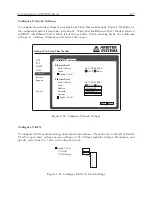
C.15 Option 34: NTP/PTP Server
153
•
Clock Jitter – is defined as the root-mean-square (RMS) average of the most recent offset
differences, and it represents the nominal error in estimating the offset (of the clock).
•
Clock wander – is the RMS of exponentially weighted frequency differences. This is not used
directly, but can, along with the jitter, be a highly useful monitoring and debugging tool.
•
Stratum – the level of each server in the hierarchy is defined by a stratum number. Primary
servers are assigned stratum one.
NTP Configure
To configure NTP follow these instructions. Figure C.28 illustrates the NTP configuration page.
Choices for the NTP Version include Versions 1, 2, 3 and 4. Multicast and Broadcast addresses
may be typed in the assigned boxes.
Option 34 Network Time Module
Status
Configure
NTP
PTP
SNMP
Clock
Network
System
Support
Logout
Authentication
NTP Version
Multicast Address
Broadcast Address
Ethernet Port 1
Ethernet Port 2
4
Apply
Reset
Figure C.28: NTP Configure Page
Summary of Contents for 1092A
Page 4: ...iv ...
Page 18: ...xviii LIST OF TABLES ...
Page 129: ...C 10 Option 20A Four Fiber Optic Outputs 111 Figure C 7 Option 20A Jumper Locations ...
Page 131: ...C 11 Option 27 8 Channel High Drive 113 Figure C 8 Option 27 Jumper Locations ...
Page 148: ...130 Options List Figure C 10 Option 29 Connector Signal Locations ...
















































